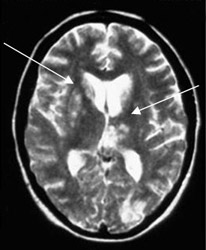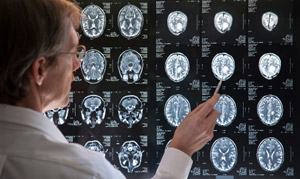also known as Cerebral Vasculitis
What is Central Nervous System Vasculitis?
Many different types of vasculitis can affect the blood vessels in the brain (called Central Nervous System Vasculitis (CNS)) including the ANCA associated vasculitides, Takayasu Arteritis and Giant Cell Arteritis.
Primary Angiitis of the Central Nervous System

When inflammation of the blood vessels of the brain is found in the absence of another cause, including other types of vasculitis or inflammatory diseases, infection or cancer it is usually called Primary Angiitis of the Central Nervous System (PACNS).
It is an inflammatory disease affecting the arteries of the brain causing a wide variety of symptoms.
Who are affected?
PACNS affects males more than females. The usual age of onset is the fourth or fifth decade of life but children can be affected as can much older patients.
What is the aetiology (cause)?
The cause of PACNS is not yet known.
What are the symptoms?
The common symptoms of PACNS are: confusion, headache and personality change. Other symptoms noted are: seizures, bleeding in the head, coma and vision loss. Occasionally patients can develop symptoms similar to stroke, which can involve a wide range of neurological symptoms, such as mobility and balance problems, speech difficulties, memory loss, hearing loss, cognitive problems, difficulties controlling arms and legs, fatigue, and bladder and bowel incontinence. Usually symptoms appear over several months but can occur quickly. Some forms of CNS vasculitis can closely mimic multiple sclerosis.
Making a diagnosis

Because of the slow onset of symptoms it can take several months or even years for the diagnosis of PACNS to be made. Many other diseases including infections and cancers can mimic PACNS and these must be excluded. The most definite way to make the diagnosis is a brain biopsy showing evidence of inflamed blood vessels. Unfortunately this test can often be misleadingly negative. MRI and CT scans are usually abnormal but the findings are not specific for PACNS. Blood tests are often normal but may show evidence of inflammation.
Treatment
As with other types of serious vasculitis high doses of steroids and cyclophosphamide are often used to bring the disease under control (establish remission). Lower dose immunosuppression is then used to maintain remission in the long term.
Drugs and Side effects
For information on the main drugs prescribed for Central Nervous System Vasculitis see:
For information on other drugs used in the treatment of vasculitis see Glossary of drugs and side effects.
Prognosis
Relapse occurs in about a quarter of cases. With correct treatment the prognosis is much better than in the past. If diagnosed quickly there is a greater chance of a more complete recovery. If diagnosis is significantly delayed it is more likely that the patient will be left with permanent neurological problems. Longer-term if the disease relapses and subsequently proves difficult to control it can take a more progressive form.
Key points
- PACNS is very rare
- Organs involved include the brain and spinal cord
- Symptoms are non-specific and may develop over a long period of time
- Treatment depends on disease severity.
The BrainWorks Study
Doctors caring for patients with inflammatory brain diseases including CNS vasculitis around the world have teamed up with basic science and clinical researchers, families, medical specialists and supportive organizations to establish a network that we call BrainWorks. The BrainWorks team built a web-based, international prospective cohort of patients from around the world with brain inflammation. The patients’ privacy is highly protected, no personal, identifiable information is included. Brainworks Website
Related Vasculitis Articles
- Fertility and Vasculitis – Dr David Jayne
Further reading
- Diagnosis and treatment of cerebral vasculitis – Peter Berlit
- Primary Angiitis of the Central Nervous System – Julius Birnbaum, MD; David B. Hellmann, MD
- Vasculitis Paediatric Guidelines 2012 – Dr Helen Foster & Dr Paul Brogan, Oxford University Press
- Article: Central Nervous System Vasculitis: Still More Questions than Answers
Personal stories
The personal story of a patient with CNS vasculitis can be viewed at: Viv’s story
This page was updated in 2015
